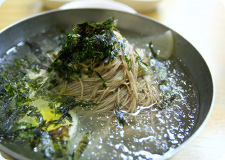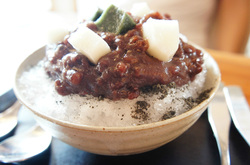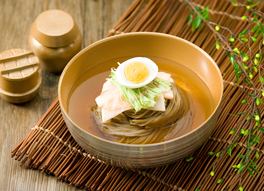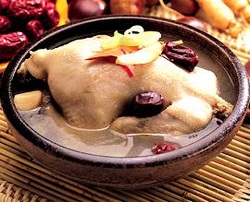 MemilguksuAnother popular food in Korea is memilguksu (메밀국수, buckwheat noodles), which are served cold as ‘makguksu’ or hot as ‘jangguksu.’ In the summer, the most popular buckwheat noodle dish is memilmakguksu, in which noodles are placed in a kimchi broth with cucumbers, kimchi, vegetables, and meat and mixed with red chili paste. Another favorite dish is memilsoba, in which the noodles are served with a soy based-broth dipping sauce that is flavored with ground radish, scallion, and horseradish.
Many people may be familiar with ‘soba’ (the Japanese name for buckwheat noodles), but there is a slight difference in the way that memilguksu and soba are made and eaten. The broth for the Korean memilguksu is made mostly of myeolchi (dried anchovy), while the broth for Japanese Soba is made with katsuobushi (dried bonito flakes). Another main difference is that Korean memilguksu is served in a broth, while the noodles and broth of the Japanese Soba are served separately.
 Bingsu (shaved ice with toppings) is a popular snack food found almost everywhere in Korea during the summer months. Believed to date back all the way to the Joseon Dynasty, the original bingsu was served simply as finely broken ice chips topped with sweetened red bean porridge. In the years following its debut, the popularity of bingsu exploded across the nation, bringing with it an almost endless variety of bingsu types and flavor combinations. Today, many bingsus shy away from the predominantly bean taste; some even omit the red beans altogether. From the traditional patbingsu of red beans and ice to complex mixes of ice cream and fruit, bingsus can easily be found in almost any coffee shop or bakery in Korea. Here, we’ll introduce you to the best of both worlds, giving you plenty of places where you can indulge in a sweet and delicious bingsu treat.
While ice cream has long since been a favorite summertime treat in the West, it is only in the last century that ice cream has become widespread in Korea. Though ice cream is now readily available, bingsu is still very popular in Korea in the summer and can be found in almost every café. Bingsu is a dessert made of ice chips, fruit, rice cake, sweetened milk, and syrup. Rather than just the original patbingsu (bingsu with red beans), a wide array of bingsu like sweet red bean bingsu, fruit bingsu, green tea bingsu, and coffee bingsu has become more popular these days. In recent years, ice cream has been added to the mix, but there are still plenty of places serving up the original version of this tasty treat.
 Naengmyeon (냉면), a buckwheat noodle dish, is perhaps one of the most beloved summer foods in Korea. Surprisingly, naengmyeon first appeared in North Korea as a specialty dish that was eaten only during the winter months. The North Korean style noodles, Pyeongyang naengmyeon and Hamheung naengmyeon, are now famous throughout the entire country and can be found in almost any neighborhood. The biggest difference between Pyeongyang naengmyeon (mul naengmyeon) and Hamheung naengmyeon (bibim naengmyeon) is the way in which they are served; Pyeongyang naengmyeon is served in a chilled broth, while Hamheung naengmyeon comes topped with spicy red chili sauce. Naengmyeong dishes are usually garnished with sliced beef, a boiled egg, cucumbers, and pears.
The two main varieties of naengmyeon are mul naengmyeon (물 냉면) and bibim naengmyeon (비빔 냉면). The former is served as a cold soup with the noodles contained in broth made from beef, chicken or dongchimi. The latter is served with a spicy dressing made primarily from gochujang (red chili paste) and eaten all mixed. In the case of bibim naengmyeon, a bowl of the soup broth used in mul naengmyeon or plain broth from the boiled noodles itself are often served on the side.
 The hottest days in Korea are from early July to mid August. This period is called ‘sambok deowi,’ or ‘the heat of sambok.’ ‘Sambok’ refers to the hottest days in Korea according to the lunar calendar and is further broken down into: Chobok (초복), the beginning period, Jungbok (중복), the middle, and Malbok (말복), the tail end of the summertime heat.
Since samgyetang is packed with nutritious ingredients, it is widely known for its restorative properties. The dish is prepared by taking a young chicken and stuffing it with garlic, rice, jujube, ginger, licorice root, and other herbs. The ingredients are then boiled together and served up in a delicious broth. Some restaurants even offer variations of the traditional Samgyetang, allowing you to add different ingredients according to your personal tastes. For a delicious and nutritious combination, try the abalone samgyetang, typically priced somewhere between 10,000 and 13,000 won.
There are two main schools of thought in Korea when it comes to summer foods. Many Koreans eat cool dishes (chilled noodles, etc.) to try and cool off, but there are also many people that eat hot foods full of nutrition to combat fatigue. This idea of ‘Yi Yeol Chi Yeol’ (fighting heat with heat) is derived from the principles of traditional Korean medicine. Originally, the term was used to refer to a medical treatment for curing colds in which a feverish patient’s body was kept as warm as possible in order to release the heat from the body. In the spirit of ‘Yi Yeol Chi Yeol,’ fight heat with heat and rejuvenate yourself this summer by indulging in a big bowl of samgyetang.
|




 RSS Feed
RSS Feed